One of our favourite online places is 'La collectionneuse'. Marlene Pilaete creates here beautiful albums with her vintage postcards of international film actresses. Each album is a precious, glittering diamond. But doesn't Marlene collect postcards of male stars? Yeah, she does, and today EFSP can present you a selection!
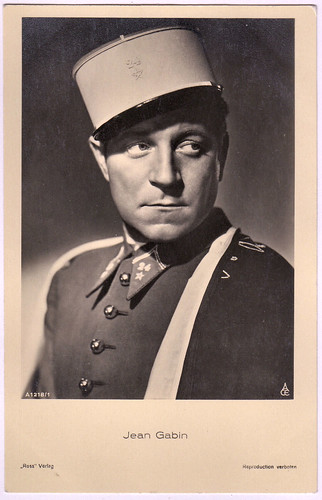
German postcard by Ross Verlag, no, A 1218, 1937-1938. Photo: ACE. Collection: Marlene Pilaete. Comment Marlene: "my favourite French actor in one of my favourite French movies, Gueule d'amour (1937)."
French actor and war hero Jean Gabin (1904-1976) was one of the great stars of the European cinema. In the 1930s he became the personification of the tragic romantic hero of the poetic realist film. Whether he played a legionnaire in Gueule d'amour (1937), a deserter in Le Quai des brumes (1938) or the head gangster in Pépé le Moko (1937), Gabin was impeccable, bringing a tragic humanity to each of his appearances which the public adored. After the war Gabin was reborn as a tough anti-hero, set in his beliefs, feared and respected by all, the Godfather of French cinema.

German postcard by Photochemie, no. K. 1743. Photo: Alex Binder, Paris. Collection: Marlene Pilaete.
Ernst Lubitsch (1892-1947) was a German-American actor, screenwriter, producer and film director. His urbane comedies of manners gave him the reputation of being Hollywood's most elegant and sophisticated director; as his prestige grew, his films were promoted as having ‘the Lubitsch touch.’ He was nominated three times for the Oscar for Best Director and in 1947, he received an Honorary Academy Award.
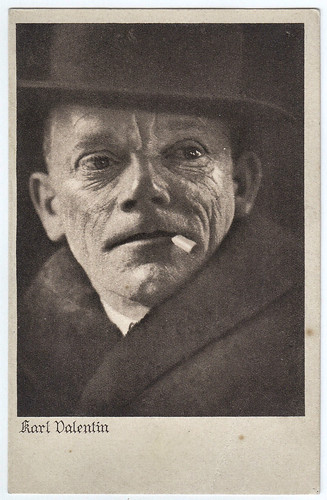
German postcard by Heliogravüre J.B. Obernetter, München. Collection: Marlene Pilaete.
Bavarian comedian Karl Valentin (1882-1948) starred in many silent German films in the 1920s. Valentin was also active as a cabaret performer, clown, author and film producer, and was sometimes called the 'Charlie Chaplin of Germany'. His work influenced artists like Bertolt Brecht and Samuel Beckett.
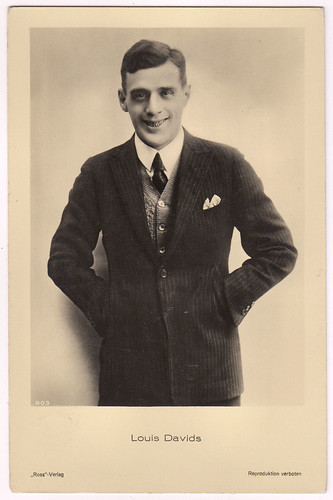
German postcard by Ross Verlag, no. 803, 1925-1926. Collection: Marlene Pilaete.
Louis Davids (1883-1939) was a Dutch cabaret and revue artist who also appeared in several Dutch films, both during the silent and the sound era. He is widely considered one of the Netherlands' biggest names in performing arts ever.
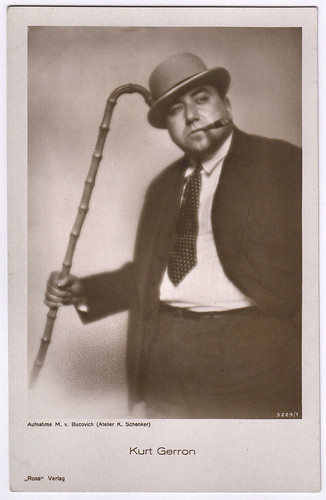
German postcard.by Ross Verlag, no. 3229/1, 1928-1929. Photo: M. von Bukovich (Atelier K. Schenker). Collection: Marlene Pilaete.
German actor Kurt Gerron (1897-1944) starred on stage in the original version of Bertolt Brecht's and Kurt Weill's Dreigroschen Oper/Three-Penny Opera as Tiger Brown. He also participated in the very successful films Die Drei von der Tankstelle/The Three of the Gas Station (1930) and Der Blaue Engel/The Blue Angel (1930). The Ufa offered him to work as a director, but in 1933 he was forced by the Nazis to leave the film studio. He left Germany, and worked successfully as a director in the Netherlands. In 1943 he was sent to a concentration camp and was forced to direct the propaganda-pseudo-documentary Der Fuehrer schenkt den Juden eine Stadt (1944). After that he was murdered in Auschwitz.
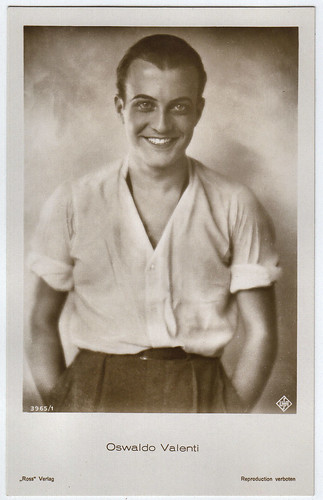
German postcard by Ross Verlag, no. 3965/1, 1928-1929. Photo: Ufa. Publicity still for Ungarische Rhapsodie/Hungarian Rhapsody (Hanns Schwarz, 1928). Collection: Marlene Pilaete.
Osvaldo Valenti (1906-1945) was an Italian film actor, who appeared in 56 films between 1928 and 1945. He and his lover, actress Luisa Ferida, were executed by partisans in Milan, Italy, due to their links with Fascism.
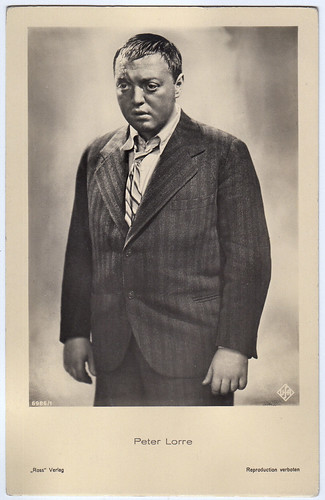
German postcard by Ross Verlag, no. 6989/1, 1931-1932. Photo: Ufa. Publicity still for Schuß im Morgengrauen/A Shot at Dawn (Alfred Zeisler, 1932). Collection: Marlene Pilaete.
Peter Lorre (1904–1964) with his trademark large, popped eyes, his toothy grin and his raspy voice was an American actor of Jewish Austro-Hungarian descent. He was an international sensation as the psychopathic child murderer in Fritz Lang’s M (1931). He later became a popular actor in two British Hitchcock thrillers and in a series of Hollywood crime films and mysteries. Although he was frequently typecast as a sinister foreigner in the US, he also became the star of the successful Mr. Moto detective series.
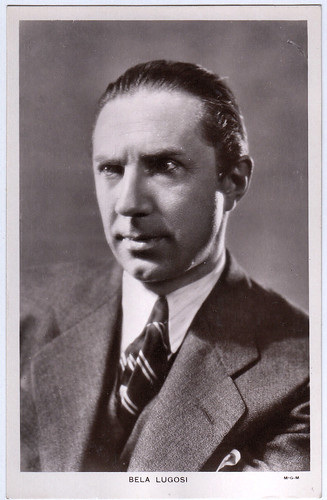
British postcard in the Picturegoer series, no. 910. Photo: MGM. Collection: Marlene Pilaete.
Hungarian actor Béla Lugosi (1882–1956) is best known as the vampire Count Dracula in the horror classic Dracula (1931). He started his film career in the silent Hungarian cinema and also appeared in German silent films. In the last phase of his career he became the star of several of Ed Wood's low budget epics and other poverty row shockers.
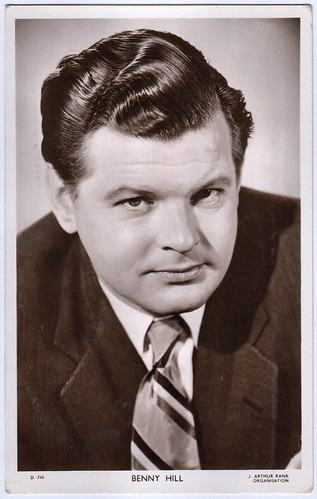
British postcard.in the Picturegoer series. no. D 745. Photo: J. Arthur Rank Organisation.Collection: Marlene Pilaete.
English comedian and actor Benny Hill (1924-1992) is best remembered for his long-running The Benny Hill Show on TV, full of slapstick, burlesque and double entendres. Hill's film credits include Those Magnificent Men in their Flying Machines (1965), Chitty Chitty Bang Bang (1968), and The Italian Job (1969).
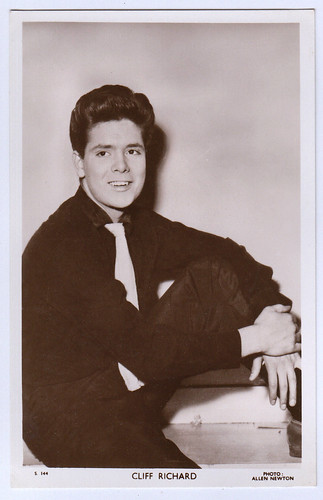
British postcard in the Picturegoer series, no. S 144. Photo: Allen Newton. Collection: Marlene Pilaete.
In the late 1950s, British singer, actor and Sir Cliff Richard (1940) was known as Britain's answer to Elvis Presley. The ‘Cliff Richard musical’ became the number one cinema box office attraction in Britain for both 1962 and 1963.
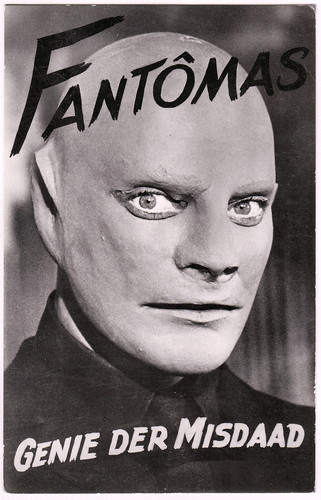
Dutch promotional postcard for Fantômas (André Hunebelle, 1964). Caption: Fantomas - Genius of crime. Collection: Marlene Pilaete.
With his heroic physique, Jean Marais (1913-1998) was France’s answer to Errol Flynn, the epitome of the swashbuckling romantic hero of French cinema. The blonde and incredibly good-looking actor played over 100 roles in film and on television, and was also known as a director, writer, painter and sculptor. His mentor was the legendary poet and director Jean Cocteau, who was also his lover.
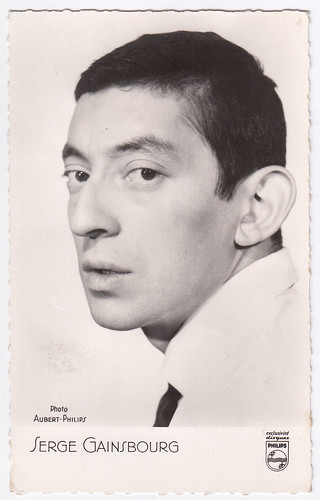
French postcard. Photo: Aubert-Philips. Collection: Marlene Pilaete.
French singer and composer Serge Gainsbourg (1928-1991) was one of the most important figures in French pop music, renowned for provocative and scandalous releases as Je t'aime... moi non plus, as well as for his artistic output, which embodied many genres. He appeared in several French and Italian films and directed four films, in which his longtime lover Jane Birkin starred.
Over the years, Marlene Pilaete has acquired quite a few male stars postcards but they were unsorted, she wrote me a while ago. At my request, she started to sort them out and mailed me: "I've began little by little to sort them out ... but I didn't realize that I had so many." Finally, after Christmas, a mail from Brussels, Belgium arrived: "It was not easy but I hope that the choices I've made will be interesting. Of course, I've chosen European people and I've selected postcards which are not on your blog." And what a wonderful selection it is: full of interesting curiosities (Benny Hill!) and beautiful, little-seen images of classic stars. I especially adore the incredible Louis Davids and Kurt Gerron postcards. Never seen before, never!
Merci beaucoup, Marlene!

German postcard by Ross Verlag, no, A 1218, 1937-1938. Photo: ACE. Collection: Marlene Pilaete. Comment Marlene: "my favourite French actor in one of my favourite French movies, Gueule d'amour (1937)."
French actor and war hero Jean Gabin (1904-1976) was one of the great stars of the European cinema. In the 1930s he became the personification of the tragic romantic hero of the poetic realist film. Whether he played a legionnaire in Gueule d'amour (1937), a deserter in Le Quai des brumes (1938) or the head gangster in Pépé le Moko (1937), Gabin was impeccable, bringing a tragic humanity to each of his appearances which the public adored. After the war Gabin was reborn as a tough anti-hero, set in his beliefs, feared and respected by all, the Godfather of French cinema.

German postcard by Photochemie, no. K. 1743. Photo: Alex Binder, Paris. Collection: Marlene Pilaete.
Ernst Lubitsch (1892-1947) was a German-American actor, screenwriter, producer and film director. His urbane comedies of manners gave him the reputation of being Hollywood's most elegant and sophisticated director; as his prestige grew, his films were promoted as having ‘the Lubitsch touch.’ He was nominated three times for the Oscar for Best Director and in 1947, he received an Honorary Academy Award.

German postcard by Heliogravüre J.B. Obernetter, München. Collection: Marlene Pilaete.
Bavarian comedian Karl Valentin (1882-1948) starred in many silent German films in the 1920s. Valentin was also active as a cabaret performer, clown, author and film producer, and was sometimes called the 'Charlie Chaplin of Germany'. His work influenced artists like Bertolt Brecht and Samuel Beckett.

German postcard by Ross Verlag, no. 803, 1925-1926. Collection: Marlene Pilaete.
Louis Davids (1883-1939) was a Dutch cabaret and revue artist who also appeared in several Dutch films, both during the silent and the sound era. He is widely considered one of the Netherlands' biggest names in performing arts ever.

German postcard.by Ross Verlag, no. 3229/1, 1928-1929. Photo: M. von Bukovich (Atelier K. Schenker). Collection: Marlene Pilaete.
German actor Kurt Gerron (1897-1944) starred on stage in the original version of Bertolt Brecht's and Kurt Weill's Dreigroschen Oper/Three-Penny Opera as Tiger Brown. He also participated in the very successful films Die Drei von der Tankstelle/The Three of the Gas Station (1930) and Der Blaue Engel/The Blue Angel (1930). The Ufa offered him to work as a director, but in 1933 he was forced by the Nazis to leave the film studio. He left Germany, and worked successfully as a director in the Netherlands. In 1943 he was sent to a concentration camp and was forced to direct the propaganda-pseudo-documentary Der Fuehrer schenkt den Juden eine Stadt (1944). After that he was murdered in Auschwitz.

German postcard by Ross Verlag, no. 3965/1, 1928-1929. Photo: Ufa. Publicity still for Ungarische Rhapsodie/Hungarian Rhapsody (Hanns Schwarz, 1928). Collection: Marlene Pilaete.
Osvaldo Valenti (1906-1945) was an Italian film actor, who appeared in 56 films between 1928 and 1945. He and his lover, actress Luisa Ferida, were executed by partisans in Milan, Italy, due to their links with Fascism.

German postcard by Ross Verlag, no. 6989/1, 1931-1932. Photo: Ufa. Publicity still for Schuß im Morgengrauen/A Shot at Dawn (Alfred Zeisler, 1932). Collection: Marlene Pilaete.
Peter Lorre (1904–1964) with his trademark large, popped eyes, his toothy grin and his raspy voice was an American actor of Jewish Austro-Hungarian descent. He was an international sensation as the psychopathic child murderer in Fritz Lang’s M (1931). He later became a popular actor in two British Hitchcock thrillers and in a series of Hollywood crime films and mysteries. Although he was frequently typecast as a sinister foreigner in the US, he also became the star of the successful Mr. Moto detective series.

British postcard in the Picturegoer series, no. 910. Photo: MGM. Collection: Marlene Pilaete.
Hungarian actor Béla Lugosi (1882–1956) is best known as the vampire Count Dracula in the horror classic Dracula (1931). He started his film career in the silent Hungarian cinema and also appeared in German silent films. In the last phase of his career he became the star of several of Ed Wood's low budget epics and other poverty row shockers.

British postcard.in the Picturegoer series. no. D 745. Photo: J. Arthur Rank Organisation.Collection: Marlene Pilaete.
English comedian and actor Benny Hill (1924-1992) is best remembered for his long-running The Benny Hill Show on TV, full of slapstick, burlesque and double entendres. Hill's film credits include Those Magnificent Men in their Flying Machines (1965), Chitty Chitty Bang Bang (1968), and The Italian Job (1969).

British postcard in the Picturegoer series, no. S 144. Photo: Allen Newton. Collection: Marlene Pilaete.
In the late 1950s, British singer, actor and Sir Cliff Richard (1940) was known as Britain's answer to Elvis Presley. The ‘Cliff Richard musical’ became the number one cinema box office attraction in Britain for both 1962 and 1963.

Dutch promotional postcard for Fantômas (André Hunebelle, 1964). Caption: Fantomas - Genius of crime. Collection: Marlene Pilaete.
With his heroic physique, Jean Marais (1913-1998) was France’s answer to Errol Flynn, the epitome of the swashbuckling romantic hero of French cinema. The blonde and incredibly good-looking actor played over 100 roles in film and on television, and was also known as a director, writer, painter and sculptor. His mentor was the legendary poet and director Jean Cocteau, who was also his lover.

French postcard. Photo: Aubert-Philips. Collection: Marlene Pilaete.
French singer and composer Serge Gainsbourg (1928-1991) was one of the most important figures in French pop music, renowned for provocative and scandalous releases as Je t'aime... moi non plus, as well as for his artistic output, which embodied many genres. He appeared in several French and Italian films and directed four films, in which his longtime lover Jane Birkin starred.
12 Men
Over the years, Marlene Pilaete has acquired quite a few male stars postcards but they were unsorted, she wrote me a while ago. At my request, she started to sort them out and mailed me: "I've began little by little to sort them out ... but I didn't realize that I had so many." Finally, after Christmas, a mail from Brussels, Belgium arrived: "It was not easy but I hope that the choices I've made will be interesting. Of course, I've chosen European people and I've selected postcards which are not on your blog." And what a wonderful selection it is: full of interesting curiosities (Benny Hill!) and beautiful, little-seen images of classic stars. I especially adore the incredible Louis Davids and Kurt Gerron postcards. Never seen before, never!
Merci beaucoup, Marlene!
No comments:
Post a Comment